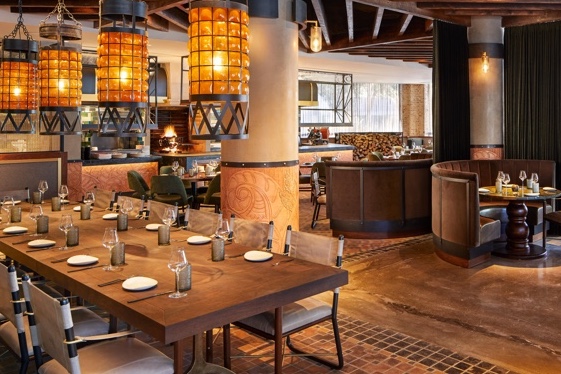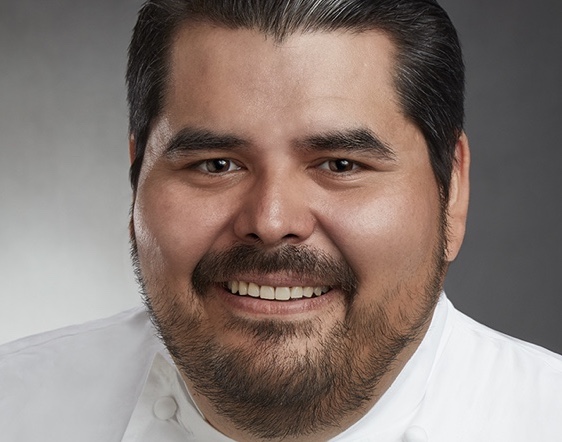In El Paso, Texas, Ambar Restaurante and rooftop bar La Perla have been two of the most anticipated restaurant openings in town, especially since they were anchoring the restoration of downtown’s historic Plaza Hotel. In addition to the standard construction delays, though, the hotel and its restaurants were thwarted by the pandemic, which required the hotel’s chef, Andres Padilla, to do some preemptive menu maneuvering before forging ahead with a restructured opening.
While that meant pressing pause on the rooftop for now, the wood-fired grill is on at Ambar, providing Padilla the space to pay homage to his hometown and serve up the “fanciest tacos in El Paso,” all while keeping safety top of mind.
HOTELS sister publication, plateonline.com, interviewed Padilla recently.

What’s it like opening new restaurants during a pandemic?
AP: It’s been eye-opening. It flashes the light on a lot of things that you wouldn’t worry about in a pre-COVID world. Our original opening date was a moving target for a while… And it really affects service. How do you set the tables? How do we give the guests an experience with a certain level of service we want to perform? From the kitchen, we have to keep our team safe and give each other enough space, and masks and gloves are the norm.
There was a lot of back-and-forth, and it’s not like we had a ton of resources. Every single person in the world was in the same boat, and learning. We’re still learning. You can see how fast things change. You have to be able to pivot, and find out what resources are best, while listening to CDC recommendations. There’s so much information that flies back-and-forth, and we ask ourselves, ‘does this feel right?’ ‘Is this the right move?’ ‘Are we protecting our guests?’ ‘Are we offering best practices in front of house and back of house, from the moment the guest walks in to the moment the guest leaves?’
Aside from delaying your opening date, what other changes did you make as a result of COVID-19?
AP: I had a large menu, and I started getting concerned about having too much food, over-prepping and losing food… We scaled back the menu a little bit, to give them a taste of what we do and keep the home runs on there, to let people get into it and see how it goes from there.
From the service side, it’s things like how we didn’t want to have silverware on the table. We want a certain level of elegance and still be able to show how we set the tables. We have a cart, so when you get in, we wheel this nice cart out in the dining room with silverware, clean linens, and sanitizer, and servers are wearing gloves, so silverware is being placed in front of you as you’re getting your drink order. Before, it would have been pre-set with wine glass, water glass, and all the silverware. It really commands a sense of elegance. So then it came down to communication after that — how the servers communicate the experience.

What are the benefits of opening new restaurants in a hotel?
AP: We’re lucky in the sense that there’s other revenue coming into the business that’s not necessarily driven by us. F&B has been the driving force, but moving forward and in the future, there’s definitely other means of revenue.
Other restaurants don’t have that space for banquets and weddings and special events; they have limited private dining rooms. To have a ballroom and breakout rooms, and be able to be so flexible and offer so many things, we have a lot more resources.
And me being a restaurant guy, there’s definitely advantages to being in a hotel. I spent the last 14 years in standalone restaurants, and it’s nice to have the resources and the luxury of having opportunities to generate revenue in a hotel, and to capture so many more guests. You also have a captive audience, because they’re staying in your hotel. Anyone who comes through the doors of the hotel, we have a captive audience that we can capitalize on.
Have locals come out to dine? Or is it mostly tourists?
AP: It’s probably at least 85% local. It’s the new shiny toy in town. There’s been so much anticipation, and because of our ownership, there was a lot of pressure to perform. The reception has been great. El Paso has been great to us. We’re operating at 50% capacity inside, and we’re reaching that point almost every night. And we also get the people that come to the hotel to have staycations. On the hotel side, it’s definitely a huge chunk of local support, versus tourists. No groups are really booking right now, but we’re still getting a decent amount of traffic, so that’s great.
What have you taken away from all this?
AP: I’ve gone through a few openings before, and opening in a hotel, there were so many things that I wasn’t thinking about, but had to remind myself of. I’ve always been a ‘big picture’ guy — as a culinary director for six busy restaurants in Chicago, I felt confident in my ability to look at the bigger picture. But there are things I’ve learned here.
I look over three outlets, essentially, but there were little things that didn’t jump out at me, like room amenities. We had to write an amenity menu, and make things for special guests. We do everything in-house, and I’m reminding myself not to lose sight of the vision — the vision for the cuisine, the vision for our menus, the vision for ownership. I’m always keeping that top of mind: Where do we want to be, where do we want to get to in every aspect of F&B at the hotel. It sounds so cliche, but keep your eye on the prize.
